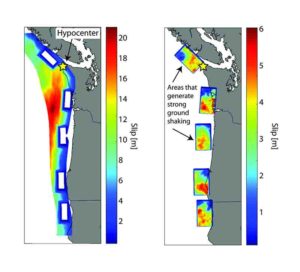
One of the worst nightmares for many Pacific Northwest residents is a huge earthquake along the offshore Cascadia Subduction Zone, which would unleash damaging and likely deadly shaking in coastal Washington, Oregon, British Columbia and northern California.
The last time this happened was in 1700, before seismic instruments were around to record the event. So what will happen when it ruptures next is largely unknown.
A University of Washington research project, to be presented Oct. 24 at the Geological Society of America’s annual meeting in Seattle, simulates 50 different ways that a magnitude-9.0 earthquake on the Cascadia subduction zone could unfold.
“There had been just a handful of detailed simulations of a magnitude-9 Cascadia earthquake, and it was hard to know if they were showing the full range,” said Erin Wirth, who led the project as a UW postdoctoral researcher in Earth and space sciences. “With just a few simulations you didn’t know if you were seeing a best-case, a worst-case or an average scenario. This project has really allowed us to be more confident in saying that we’re seeing the full range of possibilities.”
Off the Oregon and Washington coast, the Juan de Fuca oceanic plate is slowly moving under the North American plate. Geological clues show that it last jolted and unleashed a major earthquake in 1700, and that it does so roughly once every 500 years. It could happen any day.
Wirth’s project ran simulations using different combinations for three key factors: the epicenter of the earthquake; how far inland the earthquake will rupture; and which sections of the fault will generate the strongest shaking.
Results show that the intensity of shaking can be less for Seattle if the epicenter is fairly close to beneath the city. From that starting point, seismic waves will radiate away from Seattle, sending the biggest shakes in the direction of travel of the rupture.
“Surprisingly, Seattle experiences less severe shaking if the epicenter is located just beneath the tip of northwest Washington,” Wirth said. “The reason is because the rupture is propagating away from Seattle, so it’s most affecting sites offshore. But when the epicenter is located pretty far offshore, the rupture travels inland and all of that strong ground shaking piles up on its way to Seattle, to make the shaking in Seattle much stronger.”
The research effort began by establishing which factors most influence the pattern of ground shaking during a Cascadia earthquake. One, of course, is the epicenter, or more specifically the “hypocenter,” which locates the earthquake’s starting point in three-dimensional space.
Another factor they found to be important is how far inland the fault slips. A magnitude-9.0 earthquake would likely give way along the whole north-south extent of the subduction zone, but it’s not well known how far east the shake-producing area would extend, approaching the area beneath major cities such as Seattle and Portland.
The third factor is a new idea relating to a subduction zone’s stickiness. Earthquake researchers have become aware of the importance of “sticky points,” or areas between the plates that can catch and generate more shaking. This is still an area of current research, but comparisons of different seismic stations during the 2010 Chile earthquake and the 2011 Tohoku earthquake show that some parts of the fault released more strong shaking than others.
Wirth simulated a magnitude-9.0 earthquake, about the middle of the range of estimates for the magnitude of the 1700 earthquake. Her 50 simulations used variables spanning realistic values for the depth of the slip, and had randomly placed hypocenters and sticky points. The high-resolution simulations were run on supercomputers at the Pacific Northwest National Laboratory and the University of Texas, Austin.
Overall, the results confirm that coastal areas would be hardest hit, and locations in sediment-filled basins like downtown Seattle would shake more than hard, rocky mountaintops. But within that general framework, the picture can vary a lot; depending on the scenario, the intensity of shaking can vary by a factor of 10. But none of the pictures is rosy.
“We are finding large amplification of ground shaking by the Seattle basin,” said collaborator Art Frankel, a U.S. Geological Survey seismologist and affiliate faculty member at the UW. “The average duration of strong shaking in Seattle is about 100 seconds, about four times as long as from the 2001 Nisqually earthquake.”
The research was done as part of the M9 Project, a National Science Foundation-funded effort to figure out what a magnitude-9 earthquake might look like in the Pacific Northwest and how people can prepare. Two publications are being reviewed by the USGS, and engineers are already using the simulation results to assess how tall buildings in Seattle might respond to the predicted pattern of shaking.
As a new employee of the USGS, Wirth will now use geological clues to narrow down the possible earthquake scenarios.
“We’ve identified what parameters we think are important,” Wirth said. “I think there’s a future in using geologic evidence to constrain these parameters, and maybe improve our estimate of seismic hazard in the Pacific Northwest.”
Note: The above post is reprinted from materials provided by University of Washington. Original written by Hannah Hickey.










